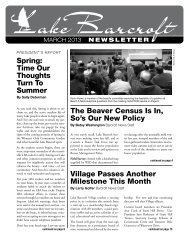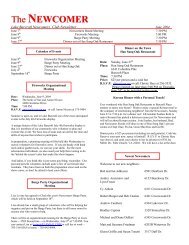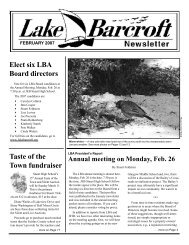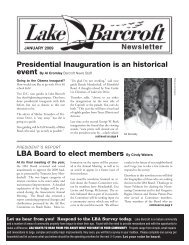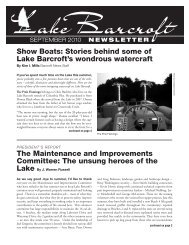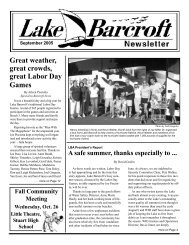Lake Barcroft History Book
Lake Barcroft History Book
Lake Barcroft History Book
You also want an ePaper? Increase the reach of your titles
YUMPU automatically turns print PDFs into web optimized ePapers that Google loves.
The <strong>Lake</strong> <strong>Barcroft</strong> Woman’s Club has an admirable<br />
45-year history of volunteer and financial support of<br />
charitable and community causes. These efforts are<br />
sometimes taken for granted, which may in part explain why,<br />
in these times, it has been increasingly difficult to enlist new<br />
members. The goal of this chapter is to recognize the unique<br />
work performed by the club and to inspire new members to<br />
carry on its often thankless but invaluable projects.<br />
The Beginning<br />
In 1955, the <strong>Lake</strong> <strong>Barcroft</strong> community, already five years old,<br />
had yet to grow out of its rustic beginnings. The houses,<br />
approximately 165 of them, were few and far between,<br />
especially in the North and Middle Areas. No enterprising<br />
cartographers had mapped the muddy trails called roads.<br />
Without the Potterton Causeway over Tripps Run, traveling<br />
around the lake from one area to another was more like going<br />
on safari rather than visiting a suburban residential<br />
development. Many new residents were young couples just<br />
starting families. Few wives worked outside the home, most<br />
preferring to stay at home with the children. The setting was<br />
ripe for an organization to unite the young pioneering women.<br />
In early 1955, Elsie Kolm and Helen O’Rourke (now Helen<br />
O’Rourke-McClary) were discussing life in <strong>Lake</strong> <strong>Barcroft</strong><br />
when Elsie mentioned how much she missed her Women’s*<br />
Club in Mantua, a nearby suburb. The conversation led to the<br />
idea of creating a similar club in <strong>Lake</strong> <strong>Barcroft</strong>. Because Elsie<br />
had considerable experience in club activities, especially<br />
federated Women’s clubs, she invited interested women to her<br />
home to explore the possibilities of forming the <strong>Lake</strong> <strong>Barcroft</strong><br />
Woman’s Club (LBWC). A representative of the Northern<br />
Virginia Federation of Women’s Clubs was present at this<br />
introductory gathering to explain the advantages of that<br />
organization. A month later, at the first meeting of the new<br />
club, the twenty-eight charter members elected Elsie president<br />
in a candlelit ceremony. In April 1956, the Virginia Federation<br />
of Women’s Clubs accepted the club’s application for<br />
membership in the Northern Virginia District.<br />
At first, the club membership was limited to fifty, the<br />
maximum number that could meet comfortably in someone’s<br />
house. Being young couples with new homes, furniture was<br />
*Most Women’s Clubs use the plural of the noun. The <strong>Lake</strong> <strong>Barcroft</strong> club<br />
uses the singular.<br />
CHAPTER TWELVE<br />
The <strong>Lake</strong> <strong>Barcroft</strong><br />
Woman’s Club<br />
49<br />
sometimes scarce, but the women made do with anything<br />
available. As the club grew, meetings were held in the hall<br />
above the Annandale Fire Department and later in the<br />
Epworth Methodist Church. Once the club had more space,<br />
membership limits no longer applied. By September 1958,<br />
members numbered more than a hundred, making LBWC one<br />
of Northern Virginia’s largest women’s clubs. In that first year,<br />
the members chose blue and white as the club colors and the<br />
sailboat as the club’s motif. Jean Stephens wrote that the<br />
members shared many laughs about the “big decisions” they<br />
had to make, such as whether to vote by raising their hands or<br />
by a voice vote of “aye” or “nay.”<br />
The mission of the Woman’s Club is detailed in its bylaws:<br />
“The purpose of this organization shall be to bring into closer<br />
unity the women of <strong>Lake</strong> <strong>Barcroft</strong> in order to promote<br />
through their common interest the cultural, educational and<br />
environmental welfare of the community.” From the<br />
beginning, the club directed its efforts toward neighborhood<br />
projects and philanthropies. The members combined social<br />
activities with fund-raising projects to raise money for worthy<br />
causes. They spent precious hours volunteering their services to<br />
assist various charitable organizations. At the same time, the<br />
women came together to further their common interests, such<br />
as literature, art, bridge and travel.<br />
Typical Projects<br />
The members worked hard their first year, setting the club’s<br />
course for the future. The first LBWC project assisted the<br />
Northern Virginia Pre-School for the Blind by donating three<br />
tables, two bulletin boards and Christmas cookies.<br />
Subsequently, members collected $270 for one child’s tuition<br />
for a year. The club also presented the <strong>Lake</strong> <strong>Barcroft</strong><br />
community with an American flag to fly over the Aqua Terrace<br />
entrance. Volunteers helped operate a bloodmobile and an Xray<br />
mobile. In addition, members spent considerable time<br />
driving children to and from the Child Development Center<br />
on Cherry Street—sometimes referred to as the Cerebral Palsy<br />
School—which was chartered in Richmond by club member<br />
Therese St. Hilaire and her colleagues on the United Cerebral<br />
Palsy board.<br />
The club’s first major undertaking involved the new Fairfax<br />
Hospital, which was then under construction on Gallows<br />
Road. In 1957, members voted to pledge $500 a year for four<br />
years to provide a memorial room in the new hospital due to



